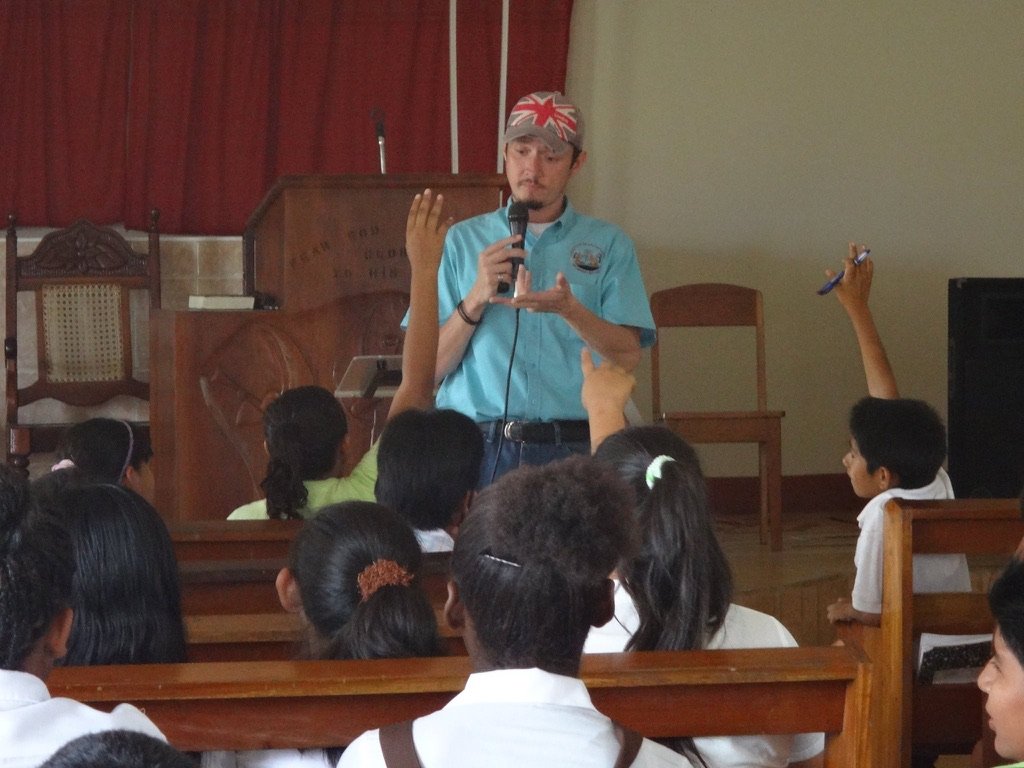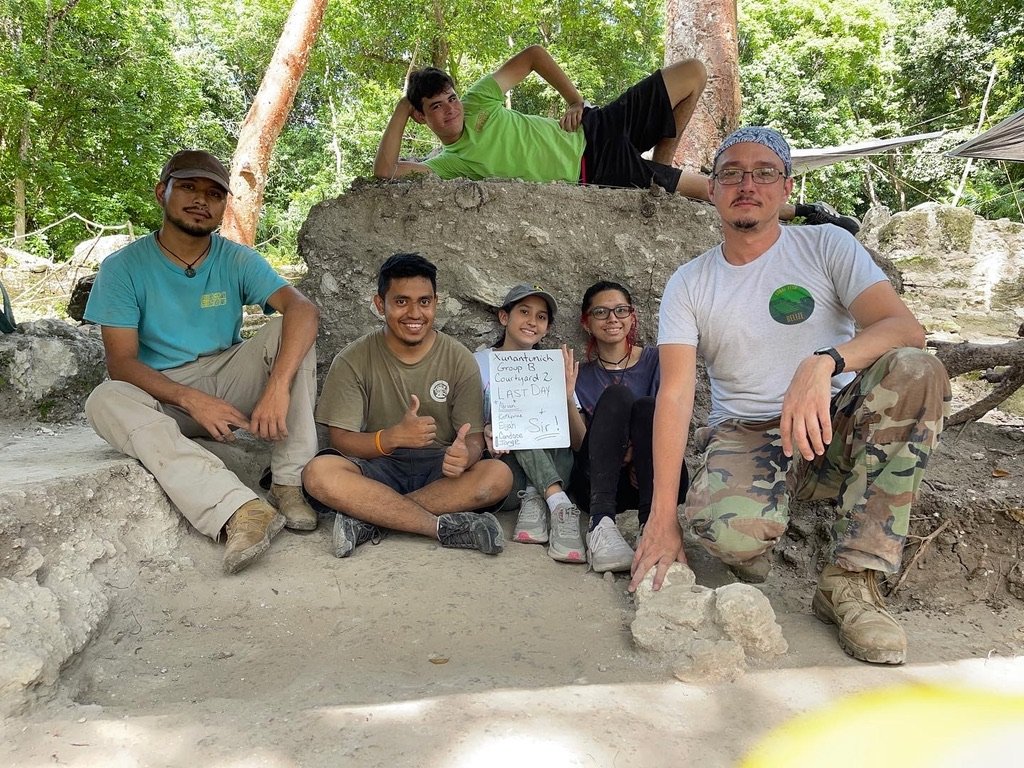Building Community, Teaching Archaeology: Interview with Antonio Beardall
Antonio leading discussions with students in the classroom © Antonio Beardall
Belizean students who get their hands in the dirt will realize that archaeology is neither about Indiana Jones’ adventures nor the projects done only by foreign experts. What does it mean for young people to excavate pieces of their ancient past? How to make ancient history and archaeology accessible to the general public? We talked with Antonio Beardall, PhD student at Texas State University, to see how community archaeology helps young Belizeans reflect on their cultural identity and own their history!
Q: First of all, could you tell our audience what your current research is about?
Antonio: I am currently a third-year PhD student at Texas State University. My research focuses on the impact being on an archaeological project has on the young people of Belize. This stems from my master's research on Belizean cultural heritage. I wanted to move from that and not just have case studies. I want to measure the actual impact from start to finish, to see how the experience of working on archaeological projects changes the way young Belizeans view their cultural and national identity. It is a pilot project, something that hasn’t been done in Belize. I try to make this work and see if something comes from it. If it gets published, other projects in Belize can see the importance of having local young people working with them—not just moving things around, but writing reports and getting involved in the excavation and analysis.
Q: What are some common misconceptions Belizean students may have about archaeology? How do they change after the students become involved in archaeology projects?
Antonio: There are two main misconceptions. The first is that archaeology is to a great extent done by foreigners, mostly white Americans who come in and run archaeological projects. These projects don’t have a really strong presence on any media, but if they are ever seen in magazines, Instagram, or the news, it’s generally a foreigner who’s running it, with Belizeans in the background doing heavy work.
Another misconception is that they (young Belizeans) can’t do it. Archaeology seems to be very mysterious and requires years of training. When they get involved, they’d realize that archaeology’s pretty simple—it’s a system and there are steps to follow. Once you know what to look for and follow the procedure, archaeology becomes straightforward. It also takes away the romance—archaeology is not what young people see in Indiana Jones. Sometimes they complain about this, but this is what archaeology really is.
Q: Are there some effective strategies you have personally used to get the general audience interested in archaeology and cultural heritage?
Antonio: The first thing that I do is break it down so they can understand what we're talking about. Sometimes archaeologists assume that the general Belizean public understands what they're saying. One of the things I do is assess who my audience will be and how technical they have to be. I've given the same presentations to a university class. I can give it to a high school class and then an elementary class and I have even gone to a kindergarten and spoken to kids about the ancient Maya and archeology. You have to know how to speak to different audiences in different ways.
People also grasp archeology better when you tie it into their lives. You can compare what we do at archaeological sites to what we do in a house. For example, I always tell students to picture their rooms, and then tell me what we can learn just by going in there and discovering items. Then it becomes clear to students that archeology is just understanding what people did and what tells us a story about them. Once you make archaeology relatable to people, they will want to hear everything. You can't go into a farming community and expect them to be very interested in ancient Maya rituals, but if you talk to them about ancient farming techniques, then you draw them in because they can make that comparison as well.
Antonio introducing archaeological materials to students © Antonio Beardall
“Once you make archaeology relatable to people, they will want to hear everything.”
— Antonio Beardall
Q: Is there a group of people you hope would be more involved in public archaeology?
Antonio: Projects coming to work in Belize need to establish an active presence in the local communities. They should carefully consult with the locals and hear their suggestions and concerns, instead of just asking who the team can hire for work. I am not saying that this is widely happening, but there is this mentality that the local population is a cheap labor force. The Belizeans who work on the projects have become skillful excavators, but because they often don’t get to tell their stories, many are not aware of how much impact they have. It would be good to get their stories out!
Then we have the NGOs who do a great job educating the public. We also have the Institute of Social and Cultural Research. HENB further provides a venue for people to exchange ideas about cultural heritage. They are all great at promoting public archaeology, but they can still get better at collaborating.
I hope to not only introduce new people to the field, but also talk to people who have already been in public archaeology for years. I have, for example, created a TikTok account to engage with young people. There was one video of a young Belizean talking about why he is in archaeology, and in two days we got 70,000 views. People want to see others who look like them doing the work, so we who have the tools to do so need to make that happen and stimulate local participation in public archaeology as much as we can!
Antonio leading field work at Xunantunich © Antonio Beardall
“I hope to not only introduce new people to the field, but also talk to people who have already been in public archaeology for years.”
— Antonio Beardall
Q: What do you think would be helpful for tourists, especially international tourists, to know about Belizean cultural heritage sites so that they can fully respect and appreciate a different country?
Antonio: When I worked at a tourist site, we would invite the different tour groups to come in and see the work that we were doing. However, some tour guides would only bring the tourists to where the foreigners work. They would ignore young Belizeans doing archeology. It hurts and confuses the young Belizeans who do not get recognized for doing the same work. I think tour guides can at least briefly mention to the tourists how the laws of Belize govern cultural heritage, and how looting destroys sites and causes us to lose parts of the history of Belize. We can encourage tourists to buy replicas, so that people who make replicas of artifacts feel empowered and assured that their culture is being appreciated. Tourists should know that by buying replicas instead of trying to find someone illicitly selling antiquities, they are supporting local people and helping to safeguard Belizean cultural heritage.
I also hope tour guides can invite tourists to come back and spend a couple of more days being immersed in the culture. It's not just archeological tourism that brings tourists to Belize. Cultural tourism is now a growing sector and different villages are opening up their homes and their businesses for foreigners to come in. It would be great if tour guides can join the archeological and the cultural sides in one tour because they basically complement each other.
Q: What recent news (latest developments or trends) about Belize’s cultural heritage would you want to highlight for our audience? Why is it significant?
Antonio: One of the recent developments comes from the Institute of Archaeology. The institute has a new director. She says there are changes to how archaeological sites and cultural heritage are managed in Belize. Previously the Archaeological Impact Assessment was not essential or connected to the Environmental Impact Assessment. The new director is making sure that whenever a construction project is going on, the archeological impact has to be assessed as part of the EIA. She wants to stress that the destruction of our cultural heritage can’t continue. She also told me that the penalties for the destruction of cultural heritage sites will be increased. Previously the penalty was low and people were not thinking twice about acting irresponsibly at those sites.
There are also important updates in education. The Institute of Archaeology is creating 3D replicas of artifacts, so they are teaching their young staff how to do that. Those replicas will be released online, and teachers will have access to them. Even if something happens to the original pieces, the Belizean audience can still access information about them. This initiative gives Belizeans more ownership over their cultural past.
Q: What changes do you hope to see happen in Belize’s cultural heritage management a few years from now?
Antonio: One of the major changes I’d like to see in 10 years is that young people become more interested in focusing on anthropology or archaeology as a career. I hope that Belize will have an accredited graduate program in archaeology and anthropology. We currently have something at the undergraduate level at Galen University, which is fantastic. A key reason why I am doing what I am doing is to effect some change in Belize’s education, hopefully starting a university program that is respected worldwide.
I also hope to see more archaeological projects led by Belizeans. They shall be the ones who come with the research questions, the funding, and the methodology. I love being in academia, but Western academia focuses on certain things and perspectives. I’d love to see archaeological projects by locals and for locals, and, in some cases, incorporating our local stories. I look forward to a future with great representation and greater community involvement in archaeology, where public archaeology will not just be something that looks good on a grant application, and that the data generated from it will be treated seriously.
People want to see others who look like them doing the work, so we who have the tools to do so need to make that happen and stimulate local participation in public archaeology as much as we can!
— Antonio Beardall
The interview was conducted and edited by Roxana Wang.



